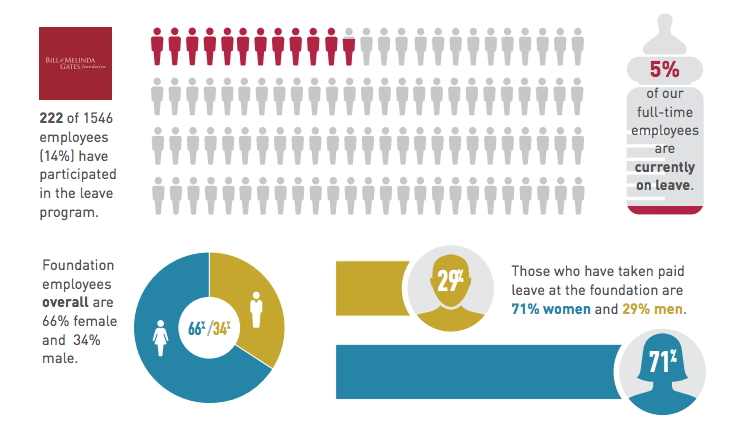In 2015, when the race to offer paid parental leave benefits was heating up, leaders at the Bill and Melinda Gates Foundation asked themselves if their policy aligned with their mission to support healthy families as an organization.
In a matter of weeks, the Gates Foundation’s top brass approved a policy that took the program from 12 weeks to up to 52 weeks of paid time off for mothers and fathers in the first year of a child’s birth or adoption. Those parents already on leave when the announcement was made were also eligible for the extended benefit. With the exception of Netflix, not many other companies (for-profit or not) were giving workers (of both genders) a chance to take a full year off to be with their new babies.
In the absence of a federally mandated paid leave policy, some states and cities have implemented their own, while private and public companies also created their own policies.
Fast Company has reported on organizations one-upping each other to extend their leave offerings (in an effort to be more inclusive and attract talent) that range from 12 weeks to six months to make up for the fact that the U.S. can’t compete with other countries on offering paid parental leave to its workforce. The U.S. is the only country among the 42 developed nations analyzed by the Organization for Economic Cooperation and Development (OECD) that does not have any federally mandated paid leave policy. And this interactive map shows how far behind we are compared to the rest of the world.

Challenges: “This Is A Work In Progress For Us”
It puts pressure on the leadership team when they have an individual leave. The management team, while they appreciate the intent of the program, have a hard time understanding, “How do I still get work done when I have a key individual key contributor out for that length of time?”
Managers are now learning how to quantify the work that needs to get done, how to reset goals and expectations across the team, how to train a backfill individual that’s going to be there for 12 to 18 months. We have toolkits. We do learning sessions and focus groups for the management team.
The other component for that manager is, “How do I reintroduce the individual that’s coming back into the organization?” Like any dynamic organization, a year is a long time in terms of how many changes or shifts happen. So we’ve actually had managers do a new hire orientation to bring the individual back in. We weren’t anticipating the depth of how much that work was going to be for the manager. So those are the two areas that we underestimated, and probably where we still continue to do a lot of our work.
Fathers: “They Need Some Additional Coaching Or Guidance”
Men who are in leadership roles feel a different type of stress or pressure on needing to want to take some time off but get back into the job. They probably hang onto the work much more strongly than a man in an individual contributor role. So we’re working on how can they actually delegate work and responsibilities, still feel supported, and feel that their re-entry would be managed.
Disconnecting: “It’s Case By Case”
We’ve had to be extremely prescriptive that the individual going on leave is the person who actually describes what connectivity looks like. Before someone goes out, we spend a lot of time with them, asking what good and bad connectivity looks like. We don’t want to prescribe that it has be zero offline.
We have a lot of type A personality folks here who want to stay connected. Through that conversation, we’re pushing a lot of their strongly held beliefs that they need to call in every month, or they need to be reviewing email, or still want to be in staff meetings. I’ve had three individuals on my team say, “I would like it if I can get a phone call with you for 30 minutes every three to four months,” and I say, “It needs to be what you view as being a positive connection back into the organization.”
The intention of the program is for them to spend as much quality time with their newborn, so we’re going to draw a line. If they continue to push back, we’ll consider removing connectivity and doing other things, but we don’t want to do that. What’s interesting is that once their child is either adopted or they give birth, we just find the connectivity drops dramatically.
Benefits: “We Contribute To A Healthy Family”
We see that as a significant benefit. The second benefit is that those individuals who have participated in the program are committed, highly productive, and aligned to the Foundation. We now have an individual that is going to drive even harder on behalf of the work that they do at the Foundation.
Bonus: Opportunity And Engagement
I never anticipated how we were going to manage backfills [to replace employees on leave] when we launched this program. We now have a website that shows all the opportunities popping up through the organization, and we now have people applying for these backfill positions as stretch opportunities for them to grow in their career and experiment and experience new parts of the organization that they wouldn’t have experienced previously.
One team was going through a reorganization when a person was going out on leave. Prior to that, they were on our high potential list. As we’re looking at the reorganization, we wanted her back in a leadership role, so we let her know that [position would be open for her when she came back], and so she was promoted while on parental leave.
Leaving After Leave
We’ve actually had two individuals decide to make a life change [and leave the company to stay home with their child], and we were happy about and supportive of that. We asked them to join the alumni network, and at any point in time when that decision may shift or change, we want them back. We’ve now had a small handful of individuals that have come back, and then within a year have gone back out on parental leave, so they are now on their second child. And the program doesn’t shift or change.
How To Replicate The Program At Other Companies
Invest the time. I can’t underestimate the amount of time or the approach with helping leaders to have productive conversations with individuals who are going out. I do think that reflecting on all of your people practices and policies that reinforce that you going out is not something that should be seen as negative, or should impact your ability to progress in your career in the organization, no matter the size of your organization or how much leave you actually provide.
Stay positive. There is a productivity component if you think about it as a positive versus if someone abuses it. It’s up to the organization to create a compelling environment where people want to work and do their best work. If I leaned into this from a fear perspective, we wouldn’t see the benefits that we are seeing. Look at this being a glass-half-full opportunity on getting better engagement, having people love the organization, and wanting to do even better work when they come back.
Make parental leave mission-critical. We felt it would be disingenuous if we’re out talking about creating healthy families as well as having children thrive if our internal people practices didn’t align and support that. From an HR perspective, all of our work is aligned to who we are: Outside needs to be reflected on our inside.
Recognize your brand’s excellence by applying to this year’s Brands That Matter Awards before the early-rate deadline, May 3.
